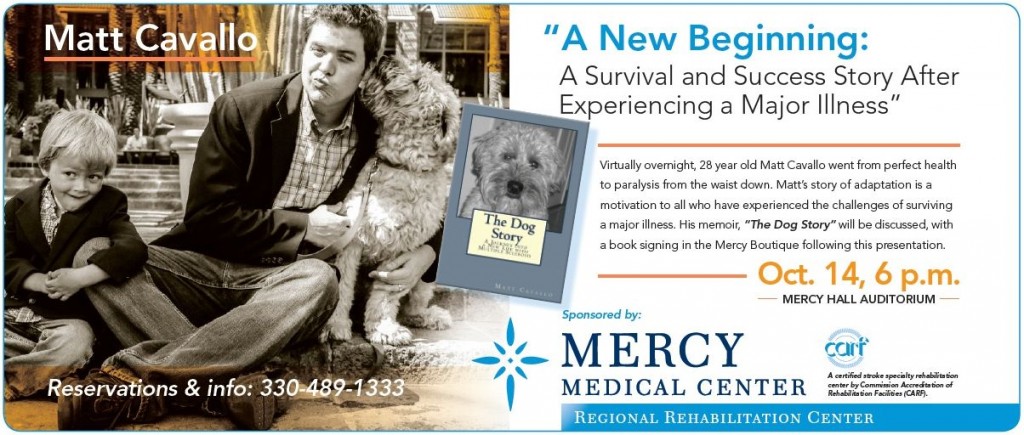When I first encountered Spalding Gray’s Monster in a Box, I was struck by the absurd yet deeply relatable concept of wrestling with an unfinished manuscript. For Gray, the “monster” was a daunting novel he couldn’t seem to finish. For me, it wasn’t just one manuscript—it was a scattered web of digital and physical fragments: old laptops, thumb drives, a 5-pound external hard drive I haven’t plugged in for over a decade, and even a green spiral notebook from 2005 that I wrote in with an IV stuck in my arm. My “monster” wasn’t in a box—it was everywhere.
The original version of The Dog Story was born out of that notebook, written during the scariest days of my life. It was raw, unfiltered, and full of the bravado of a 28-year-old who thought he could conquer MS by sheer willpower. I self-published it in 2012 and took it on the road, selling over 30,000 copies during speaking tours. Below is an ad from the Akron Beacon Journal back when I was on tour.

But while I connected deeply with audiences, COVID forced me to stop and reflect. With my stage gone and my day job back in full swing, I started going through those scattered files, revisiting the words I had written years ago.
What I found surprised me. The story I told back then wasn’t the story I wanted to leave behind. It was limited—a battle cry against MS, but it missed the deeper truths I had come to understand. It didn’t capture the love, perseverance, and faith that had carried me through the darkest times. It wasn’t the story I wanted my sons, their future children, or anyone seeking hope to read.
Spalding Gray’s monologue gave me a framework to think about this journey. Just as Gray grappled with his “monster,” I’ve been wrangling with mine: a story scattered across a digital labyrinth, needing to be reshaped and retold. The process hasn’t been easy, but it’s been transformative. I’ve realized this isn’t just a story about a man versus a disease. It’s about love—the kind that grows stronger under pressure. It’s about faith—the kind that helps you stand when you can no longer see the ground beneath you. And it’s about perseverance—the kind that drives you to keep going, even when you’re not sure where the finish line is.
Now, as I work to rewrite The Dog Story into the narrative it was always meant to be, I’m also crafting query letters to agents. Inspired by Gray’s humor and self-awareness, I’ve leaned into the absurdity and heart of this journey. My pitch is simple: I sold 30,000 books on my own—imagine what we could do together. But beyond the numbers, it’s about the story I’m ready to share with the world. The one about love, faith, and hope.
If you’ve ever felt like your work is a monster in a box (or in a web of file folders), I hope my journey inspires you.
Sometimes, the hardest thing isn’t creating—it’s revisiting, reshaping, and believing in the story you’re meant to tell. It’s about having the humility to recognize that the first draft is just the beginning and the persistence to see the story through, no matter how daunting it feels.
For me, the monster is finally coming out of the box—or, in my case, the hard drive. And with it, I’ve come to realize that taming the monster isn’t about perfection; it’s about persistence. It’s about showing up for the story, day after day, even when it feels impossible to piece together. Because in the end, it’s not just the story that grows—it’s you.
